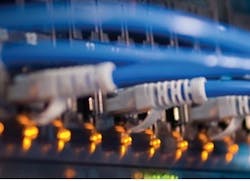A brief history of managed connectivity
By Gene Malone, TE Connectivity
As long as there have been networks, there has been a need to document and manage them. Documenting the network facilitates maintenance and repairs, and as networks have become more and more complex, the need for up-to-date documentation becomes more critical than ever. As a result, it’s not surprising that network management systems have evolved as well.
In the mid-1800s, telegraph networks were fairly simple, point-to-point affairs with just two wires. Network documentation was kept with pen and paper, and the connections from place to place were fairly obvious and easy to locate. Still, the connectivity documentation was only as accurate as the technicians’ willingness to describe what they had done to the network. Gaps in documentation and inaccuracies were common.
As telephone networks spread in the early 1900s, the network became more complex. Still using two-wire, twisted-pair connectivity, these networks added trunks and manual switches. These, too, were documented with pen and paper.
In the 1970s, electronic spreadsheets became the method of documenting network connections. In the ensuing decade, many network connections required up to four wires per circuit or were coaxial/splitter-based with many cabling standards competing for dominance, including IBM Type 1-TR, Twinax, WangNet, and Category 3 Ethernet. Wiring became more complex, and the network documentation became more complex, specifying not only the endpoints of circuits, but also the circuit type, cable type and color, and circuit capacity.
In them id to late 1990s, carriers developed purpose-built software applications to better facilitate the documentation process for cabling networks beyond the tabular format of spreadsheets. Circuits could now be graphically visualized along with rack elevations of mounted devices and floor plans with outlet locations. Network complexity increased along with corporate dependence on networks, making it crucial that documentation be maintained accurately. However, it was still up to network managers and technicians to document their work manually, and documentation was frequently inaccurate or out-of-date.
Around the turn of the millennium, several companies began tackling the problem of inaccurate manual record-keeping by introducing systems that automatically report the status of network connections to a software database. Network complexity and the consolidation of assets/networks into larger data centers drove the need for more-efficient tools to monitor, record and diagnose the network, and these management systems provided immediate information on whether or not circuits were connected.
Several competing hardware methodologies, from inferred process to ninth-wire patching, were employed to automate the detection of new or removed circuit connections. These initial approaches were limited and only satisfied the simplistic requirement of defining which points were connected. This was the beginning of what we call managed connectivity of automated infrastructure management (AIM).
Today, network requirements are even more critical. Business demands they run at higher speed with unprecedented availability, are highly secure and are built with multiple categories and levels of performance components. Length budgets and component-performance mismatches now critically affect network performance, so it’s essential to have up-to-the-minute information on the state of the physical network and additional component details necessary to assure the optimum network performance.
To meet these needs, managed connectivity has continued to evolve, so that systems provide information on the type and capacity of each circuit as well as whether or not it is connected. For example, TE Connectivity’s Quareo system uses intelligent network-connected patch panels, fiber frames, and patch cords to register the type and connection state of each circuit and update database records. Each Quareo panel and fiber frame is network connected and can receive power from Power over Ethernet or a local 24-volt power source, eliminating much of the supporting wiring attributed to previous technologies.
Quareo Connection Point Identification (CPID) technology provides pertinent details about the connecting components necessary for optimum configurations. CPID information includes a unique ID number for each assembly and component, performance ratings, length of assemblies, cable colors, polarity, part number, location and dates of manufacture, and more information.
With managed connectivity systems like Quareo, we have come a long way from pen and ink in the science of network documentation. Today’s networks must maintain a high level of security and accountability, and support rapid application deployment as well as continual changes, therefore the managed connectivity solution should have the speed and agility to keep up. CPID technology and database-driven knowledge of the network layer will ensure that managed connectivity stays up to the challenge.
Gene Malone is emerging technologies product manager at TE Connectivity (www.te.com).
